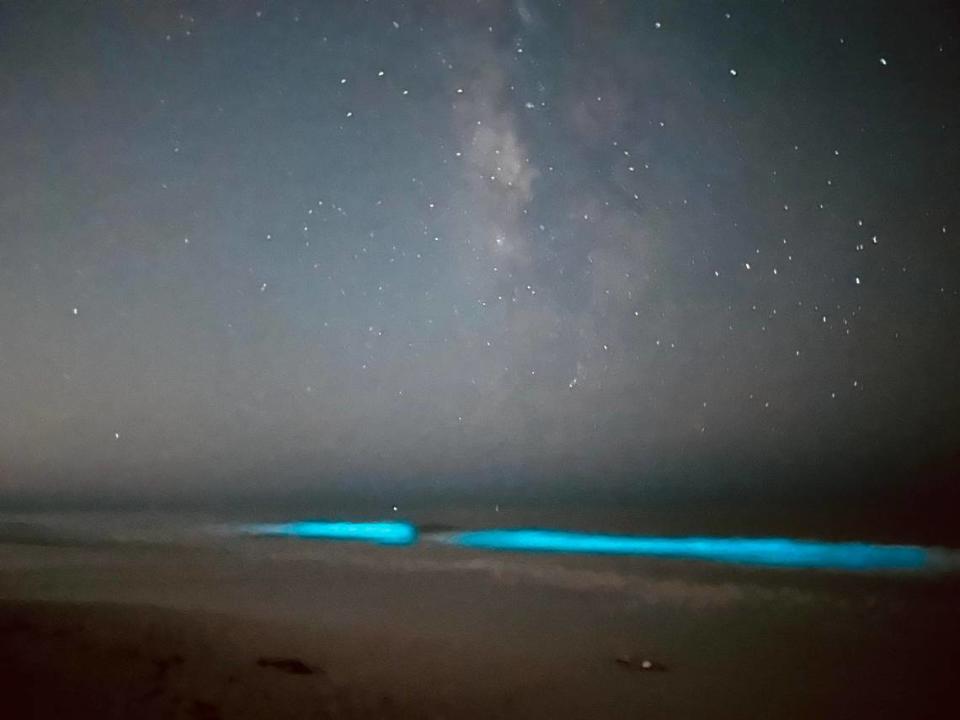Agitated creatures are making the waves glow with ‘sea sparkles’ at this Florida beach
Glowing “sea sparkles” in the nighttime waves around Anna Maria Island are stirring wonder as they catch the eyes of beach visitors.
Bioluminescence in the ocean can be caused by several types of organisms, including microscopic plankton and larger creatures such as crustaceans and jellyfish.
In Florida, bioluminescent waters are more common on the east coast, where they are usually caused by dinoflagellates — a kind of single-celled organism responsible for algae blooms.
When the organisms are agitated by waves, the hull of a boat or a predator, they flash brightly. It’s a defense mechanism that can scare away a predator or attract a secondary predator to eat the first one, according to the Scripps Institute of Oceanography in California.
For Vinde and Kareem Ali of Bradenton and their four children, Sunday night was the first time they saw sea sparkles firsthand.
“We always read and heard about such phenomenon all over the world but never thought we would have encountered it so close to home,” Vinde said in a Facebook message. “The feeling of seeing the bioluminescence was something out of a storybook, or a movie even.”
Vinde said her kids were specifically reminded of a scene from Disney’s “Moana.”
A snapshot that Vinde posted to Facebook on Monday had over 1,500 admirers, and many other photos are making the rounds on social media.

What is causing Anna Maria Island’s glowing waters?
With many species capable of creating bioluminescence, local scientists say it would be hard to pinpoint the one responsible for Anna Maria Island’s glowing waters without analyzing water samples.
Two likely candidates are Pyrodinium bahamense and Noctiluca scintillans, David Tomasko, Sarasota Bay Estuary program director, said in an email.
“The first species is mostly found in areas with low flushing rates, such as the Indian River Lagoon and Old Tampa Bay,” Tomasko said. “More likely is that it is Noctiluca scintillans, which has a common name of ‘sea sparkle.’”
Tomasko noted that the genus name Noctiluca derives from Latin for “shines by night.”
Celia Villac, a harmful-algal bloom researcher with the state’s Fish and Wildlife Research Institute, said a dinoflagellate species called Gonyaulax polygramma could also be responsible.
In a sample taken at Anna Maria Island on Monday, it was observed at strong concentrations.
“There are lots of species (not only phytoplankton) that can cause bioluminescence,” Villac said in an email. “Among phytoplankton, there are several dinoflagellates that can cause bioluminescence. It could be the culprit but, to be honest, I do not know if this concentration, although relatively high, is enough to cause the effect observed.”
Some species that create bioluminescence are also responsible for harmful algal blooms. Pyrodinium bahamense, for instance, can produce toxins, but Noctiluca scintillans does not.
The glow is produced through an enzyme called luciferase that turns chemical energy into light, Tomasko said. It’s the same way fireflies produce light.
On Anna Maria Island, locals are enjoying the magic of the unusual sight while it lasts.
With a new moon coming up on Sept. 14, skies are ideally dark to observe the phenomenon.

